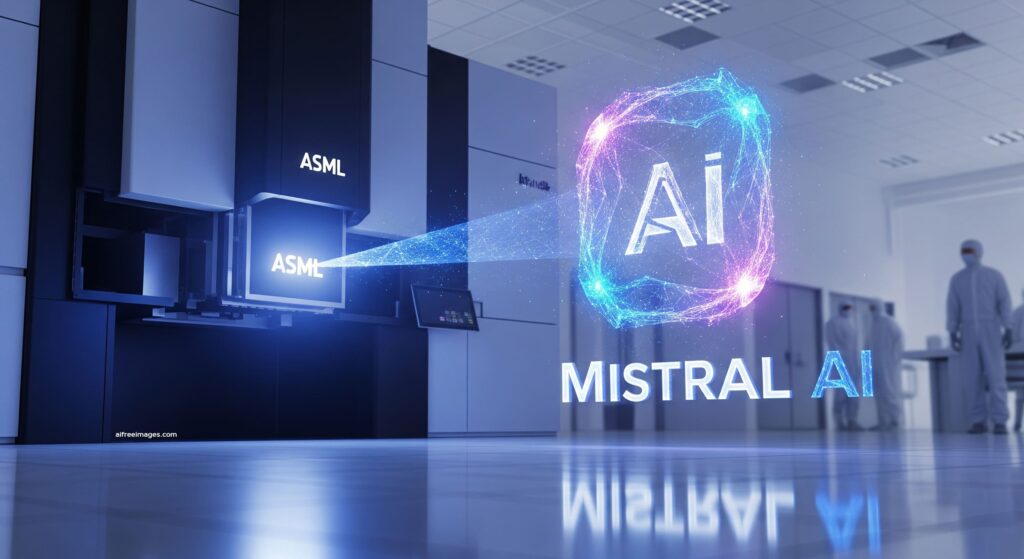ASML, the Dutch leader in advanced lithography, has made a significant move in the AI arena by becoming the majority shareholder of Mistral AI. This French startup has rapidly evolved from a promising newcomer to a European flagship in just two years. The operation, as reported by Reuters, involves a €1.3 billion investment as part of a total round of €1.7 billion, valuing Mistral at approximately €10 billion.
This isn’t a minor move. For the first time, the world’s leading provider of extreme ultraviolet (EUV) lithography machines, which are essential for producing cutting-edge chips for TSMC, Intel, and Samsung, is entering into the capital of an AI company. The dual goal is to support European technological sovereignty and to leverage Mistral’s capabilities to optimize its own industrial processes.
Chips + AI: the duo shaping the next decade
What may seem like an unlikely alliance makes more sense when viewed in context. ASML is the critical piece in the semiconductor industry: it controls over 90% of the global market for advanced lithography machines. Without its equipment, neither TSMC’s 3nm technology nor Intel’s next-generation chips would be possible. Meanwhile, Mistral AI has established itself as Europe’s alternative in language models and AI infrastructure, with an open and efficient approach contrasting with that of OpenAI, Google DeepMind, or Anthropic.
The convergence is clear: chip manufacturing now relies heavily on AI. From parameter optimization in lithography to predictive maintenance and process simulation, algorithms are transforming efficiency, yield, and costs. ASML recognizes the need for AI to maintain its leadership, and Mistral needs an industrial partner to bring strength, credibility, and access to global clients.
Mistral AI: Europe’s rising star
Founded in 2023, Mistral has already raised over $1 billion prior to this round. Its flagship product is a family of open-source language models designed for efficient inference and easy deployment in enterprise environments.
The company is also developing Mistral Compute, an AI infrastructure utilizing 18,000 NVIDIA Grace Superchips based on Blackwell. This deployment, combined with ASML’s backing, positions Mistral uniquely: competing head-to-head with giants like OpenAI or Anthropic, yet offering a more compliant with European regulations and with strategic independence from the US or China.
NVIDIA: the silent third partner
The story would be incomplete without mentioning NVIDIA, which maintains a technological and financial alliance with Mistral. The French startup depends on NVIDIA’s GPUs to build its infrastructure, yet it also brings something NVIDIA does not control: the narrative of European digital sovereignty.
With ASML as the main shareholder, the collaboration takes on new dimensions. Europe manages to connect a key hardware supplier (NVIDIA), a critical infrastructure company (ASML), and an innovative AI startup (Mistral), forming an interconnected ecosystem.
What does ASML stand to gain?
Beyond strategic considerations, there’s an operational interest: using Mistral’s AI to improve its own technology. Key areas include:
- Process control: optimizing EUV and DUV lithography parameters.
- Predictive maintenance: reducing unplanned factory downtimes.
- Advanced metrology: real-time analysis of variations and defects.
- Product development: faster simulations for future machine generations.
Each marginal improvement in these areas can translate into millions of euros in savings and a competitive edge against emerging rivals like Canon or Nikon, which are also vying for a foothold in advanced lithography.
Europe aims for its own strength
The ASML–Mistral move is interpreted as a major political-industrial strategic step. Europe cannot match the investment volumes of the US or China, but it can align strategic pieces to reduce dependency.
With Mistral valued at €10 billion, Europe now has a significant AI player. With ASML leading, this actor enjoys financial and industrial backing. The challenge now is to convert capital into competitive products and to build an ecosystem involving European cloud providers, integrators, and corporate clients.
Rumors of Apple and future acquisitions
Meanwhile, rumors suggest that Apple is interested in acquiring Mistral AI or Perplexity as part of its strategy to catch up in AI. Although nothing is confirmed yet, this new scenario complicates any potential sale: with ASML involved on the board and political implications, a full sale to a US giant would be difficult to justify in Europe.
Mistral, for its part, has expressed interest in acquiring smaller startups to expand its offerings. With strengthened finances from this round, consolidation moves could be expected in the coming months.
Conclusion: a seemingly strange but necessary move
The entry of ASML as the main shareholder of Mistral AI may seem unusual, but it reflects a reality: chips and AI are no longer separate worlds. Europe, aware of its lag behind the US and China, has decided to play its best cards: ASML’s global lithography monopoly and Mistral’s innovative open AI capabilities.
The outcome is an alliance that, if executed well, could mark a turning point in European technological sovereignty. It’s not enough just to attract more tourists — as in Spain — the real goal is keeping the spending and added value at home. In AI, this means building local players with scale and global ambition.
Frequently Asked Questions (FAQ)
How much has ASML invested in Mistral AI?
ASML committed €1.3 billion in Mistral’s latest funding round, which totals €1.7 billion.
What valuation does Mistral AI have after this round?
The French startup is valued at approximately €10 billion, making it Europe’s most valuable AI company.
What role does NVIDIA play in this story?
NVIDIA is both a technological and financial partner for Mistral, providing infrastructure with its Grace Blackwell Superchips. The investment from ASML complements this support with capital and industrial influence.
Is this movement enough for Europe to compete with the US and China in AI?
Not on its own, but it’s a significant step toward European technological sovereignty. Its success will depend on how Mistral utilizes the funds, integrates with ASML, and develops an AI ecosystem with a European footprint.
via: Reuters and Noticias inteligencia Artificial

